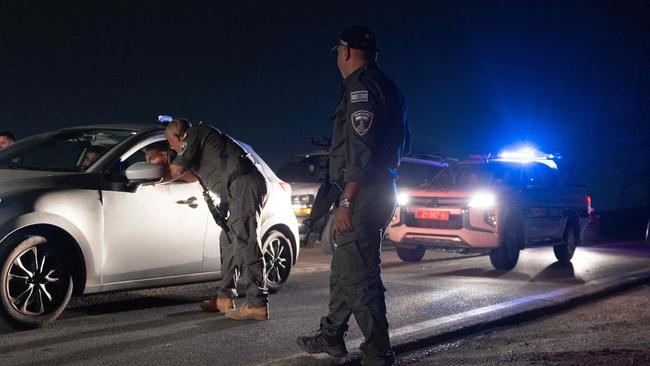Hezbollah drone strike highlights weakness in Israel defence system
The drone was able to pass detection before crashing into a military base, highlighting a weak spot in Israel’s vaunted air defence system that military officials say is hard to counter.

The Lebanese militia Hezbollah struck an Israeli military base in central Israel with a drone, killing four soldiers and wounding dozens, highlighting a weak spot in Israel’s vaunted air defence system that military officials say is hard to counter.
The drone, which was launched Sunday night, was able to pass detection by Israeli forces before crashing into a Golani infantry brigade military base near Binyamina. Overall, 61 were wounded, according to Magen David Adom, Israel’s national emergency service.
The drone didn’t set off warning sirens and struck a dining hall as soldiers were eating dinner, according to state-owned Army Radio. The drone left a large hole in the ceiling of the dining hall, with blood splattered on the floor, according to photos and videos shared in Israeli media. Hezbollah took responsibility for the attack, saying it had launched a squadron of attack drones at the base.
Current and former military officials have said that Israel has struggled to come up with adequate solutions to counter drones being fired by Hezbollah, especially at the detection stage.
While drones have played a crucial role in the war in Ukraine, Israel’s military has focused on longstanding threats such as rockets and missiles and has viewed drones – or unmanned aerial vehicles, UAVs – as a side issue.
“This was a difficult event with painful results,” said Israeli Defense Minister Yoav Gallant, who visited the Golani base on Monday. “We are concentrating significant efforts in developing solutions to address the threat of UAV attacks.”

The Israeli military said that in response to Hezbollah’s drone attack, it had issued a directive to prioritise targeting the Hezbollah drone unit, with the objective of dismantling its capabilities.
Separately, at least four Palestinians were killed in an Israeli air strike on a tent encampment for displaced people in central Gaza, which Israel said targeted militants.
A large fire broke out inside the encampment near the area of the strike, according to witnesses and footage on social media verified by Storyful, which is owned by News Corp, the parent company of The Wall Street Journal. Some 40 people were wounded as a result of the fire, including women and children, according to Palestinian health authorities.
Philippe Lazzarini, the head of the United Nations Relief and Works Agency, said a UNRWA school, which was planned to be used for a polio vaccination campaign, had also been hit in the same area, with 20 reported killed. Lazzirini said the vaccination campaign in the school was cancelled.
Asma Aljendeb, 22, was staying with her two children at a tent near the hospital as the fire started to spread. “I had to wake my children up. We left before our tent was set on fire as well,” she said.
The Hezbollah drone attack on Israel shows how the group has improved its use of drones since the start of the war, including using surveillance drones, explosive drones and first-person view drones, or FPVs, that can be navigated by an operator.
Drones have been used successfully by Ukraine against Russia’s much larger military. They are cheap compared with costly defence systems. It costs Israel around $100,000 per interception of a much cheaper drone with its Iron Dome system. Jet fighters are also considered expensive compared with more cost-effective solutions pioneered by Ukraine such as acoustic sensors and even nets.
Ukraine is the first country in the world to have opened an entirely new force in the military responsible for unmanned systems in the air, ground and sea, according to Samuel Bendett, an adviser with the strategy, policy, plans and programs division at CNA, a think tank where he is a member of the Russia studies program.

Since Israel escalated its campaign against Hezbollah last month through intensified air strikes and a land invasion, the U.S.-designated terrorist group has been hit hard, including Israel killing its leader Hassan Nasrallah and other senior commanders. Israel says that it has successfully destroyed a large percentage of Hezbollah’s weapons arsenal, which was estimated at around 150,000 missiles, rockets and UAVs before the war.
At the same time, Hezbollah has continued to fire hundreds of projectiles at Israel daily, including firing missiles at central Israel on Monday that caused no casualties, according to preliminary reports. It remains unclear how significantly Israel has been able to damage the militant group’s arsenal.
“The fact that its capabilities have been significantly harmed doesn’t mean that it doesn’t have remaining capabilities,” said Sarit Zehavi, founder and president of Alma Research and Education Center, a think tank in Israel, referring to Hezbollah.
Hezbollah has been firing large amounts of UAVs and drones at Israel for months, and it wasn’t surprising that some have been able to slip through, Zehavi said. Sunday’s attack on the military base took place under the cover of a large barrage of rockets that appeared to have been aimed at overwhelming Israeli air defences, she said.
The drone strike on Sunday follows other efforts to use drones to attack Israel. In one video from September, a Hezbollah drone surveyed an Israeli military base close to the Lebanese border, while an FPV dived at high speed toward an Israeli military vehicle. Soldiers in the vehicle jumped to the ground seconds before the drone crashed. Drone experts who reviewed the footage confirmed it showed FPVs and said the Israeli military targets in the videos appeared unprotected against them.
In May, Hezbollah launched a drone armed with missiles that crashed down onto a military base. The attack injured three soldiers, according to the military.
Israel has also faced drone attacks from the Houthis in Yemen as well as Iraqi militias since the start of the war.
While Hezbollah’s FPVs have so far only been used against military hardware, security analysts fear that their use could expand and improve, as they have in Ukraine and be used for assassinations or by relying on optic fibres which can’t be jammed.
An Israeli military official said in August that despite the fact that Israel was caught unprepared for the UAV and drone threat, the military doesn’t consider it a strategic threat.
“It’s a new front for everyone and we are in a learning battle with Hezbollah and we are trying to learn fast,” he said. “Drones at the end of the day, if you narrow it down to the nitty-gritty impact of a drone, it’s another projectile.” Others are more worried.
Iaroslav Kalinin, a former army officer in the Ukrainian military and chief executive of Infozahyst, one of Ukraine’s biggest electronic warfare contractors, compared the novel use of drones to the invention of the tank in World War I. “We all have to be prepared. This is a real threat,” he said.
Kalinin, who has been warning about the spread of FPVs, said many militaries around the world are slow to understand the scale of the new threat.
Onn Fenig, CEO of R2, a deep tech company that detects malicious activities on the wireless spectrum including drones, said Israel should expect to see more drones break through.
“We will continue seeing UAVs that succeed in passing through Israeli air defences because the air defence system wasn’t designed to deal with this threat,” Fenig said.
Dow Jones





To join the conversation, please log in. Don't have an account? Register
Join the conversation, you are commenting as Logout